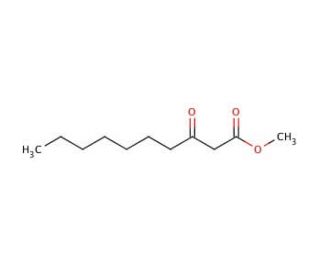

Methyl 3-Oxodecanoate 의 분자 구조, CAS 번호: 22348-96-5
Methyl 3-Oxodecanoate (CAS 22348-96-5)
CAS 등록번호:
22348-96-5
분자량:
200.27
분자식:
C11H20O3
연구용으로만 사용가능합니다. 진단이나 치료용으로 사용불가합니다.
* Refer to Certificate of Analysis for lot specific data.
빠른 링크
주문정보
설명
기술정보
안전정보
SDS 및 분석 증명서
메틸 3-옥소데카노에이트(CAS 번호 22348-96-5)는 케토산의 메틸 에스테르로 분류되는 유기 화합물로, 특히 데카노산 유도체의 세 번째 탄소에 케톤 작용기가 있는 것이 특징입니다. 이 분자 구성은 특히 케톤기를 통해 핵친화적 첨가 또는 축합과 같은 다양한 유기 합성 반응에 참여할 수 있는 상당한 화학 반응성을 부여하여 합성 화학에서 귀중한 시약이 됩니다. 연구 맥락에서 메틸 3-옥소데카노에이트는 복잡한 분자를 생산하기 위한 합성 경로 연구에 특히 유용합니다. 이는 새로운 결합이나 분자 구조를 형성하기 위해 쉽게 변형될 수 있는 작용기를 제공함으로써 정밀 화학, 향료 및 폴리머 합성의 중간체 역할을 합니다. 또한 케톤 구조는 카르보닐 함유 화합물의 안정성과 반응성을 설명하는 유기 화학의 필수 개념인 케토-에놀 이성질체의 메커니즘을 이해하는 데 중점을 둔 연구에 중요한 역할을 합니다. 이 화합물은 화학 합성에 사용되는 것 외에도 재료 과학, 특히 생분해성 플라스틱 개발에서 고분자 사슬에 통합되어 재료의 분해성과 환경 친화성을 향상시킬 수 있는 역할을 합니다.
Methyl 3-Oxodecanoate (CAS 22348-96-5) 참고자료
- 디하이드로스트렙토마이신의 자연 발생 길항제의 구조. | CORNFORTH, JW. and JAMES, AT. 1956. Biochem J. 63: 124-30. PMID: 13315257
- 감염의 바이오마커로서 슈도모나스 퀴놀론 신호의 잠재적 가치를 정량화하고 평가하기 위한 면역화학적 접근법. | Montagut, EJ., et al. 2021. Anal Chem. 93: 4859-4866. PMID: 33691411
- 표적화되지 않은 푸드오믹스는 풍미 바이주 노화에 대한 자기장 효과의 분자 메커니즘을 밝힙니다. | Jia, W., et al. 2021. Food Res Int. 149: 110681. PMID: 34600683
- 녹농균의 생합성 유연성으로 인해 수산화 2-알킬퀴놀론은 염증성 숙주 반응을 일으킵니다. | Savchenko, V., et al. 2023. Commun Chem. 6: 138. PMID: 37400564
- 강알칼리에서의 유기 반응-I: 에틸렌산의 핵분열(바렌트랩 반응). | Ackman and R. G., et al. 1960. Tetrahedron. 8.3-4: 221-238.
- 하플로필룸 아큐티폴리움의 알칼로이드. | Razzakova, et al. 1973. Chemistry of Natural Compounds. 9: 199-202.
- 알킬(트리메틸실릴) 케텐과 β-실록시알데히드의 [2+ 2] 사이클로디션을 통한 판클리신 A-E의 비대칭 합성. | Kocieński and Philip J., et al. 1998. Journal of the Chemical Society, Perkin Transactions 1. 8: 1373-1382.
- 4-하이드록시-2-피론의 3, 6 및 5, 6-디알킬 유도체 합성에 대한 새로운 접근법. 라크-게르미시딘의 합성. | Lokot, et al. 1999. Tetrahedron. 55.15: 4783-4792.
- 이종 촉매로 98% 이상의 광학 수율 달성. 타르타르산 개질 라니 니켈 수소화의 에난티오 차별화 인자에 대한 기판 설계 및 분석. | Sugimura, et al. 2002. Bulletin of the Chemical Society of Japan. 75.2: 355-363.
- 삼중수소 표지 및 광 활성화 가능한 N-아실-l-호모세린 락톤의 합성: 왕국 간 신호 전달 분자. | Jakubczyk, et al. 2014. European Journal of Organic Chemistry. 2014.3: 592-597.
주문정보
| 제품명 | 카탈로그 번호 | 단위 | 가격 | 수량 | 관심품목 | |
Methyl 3-Oxodecanoate, 100 mg | sc-211848 | 100 mg | $300.00 | |||
Methyl 3-Oxodecanoate, 1 g | sc-211848A | 1 g | $1801.00 |
